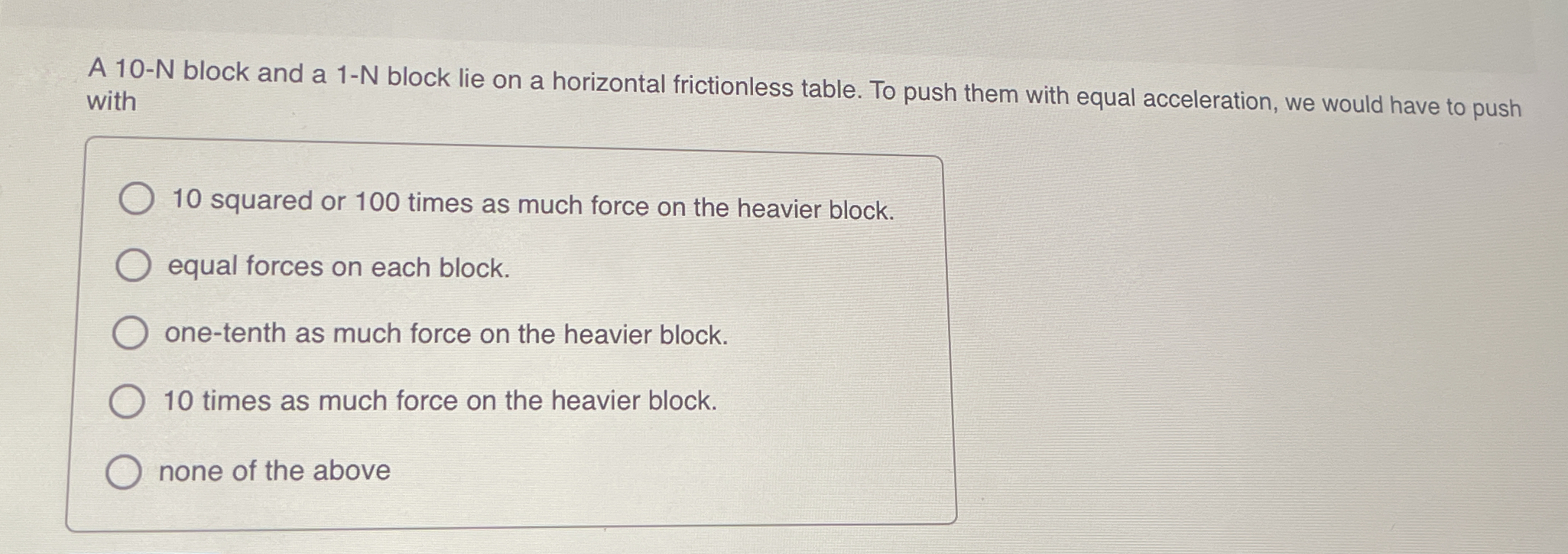A 10-N block and a 1-N block lie on a horizontal frictionless table. To push them with equal acceleration, we would have to push with?

Understand the Problem
The question is asking how much force would need to be applied to push a 10-N block and a 1-N block on a frictionless surface so they accelerate equally. It involves understanding Newton's second law of motion, which relates force, mass, and acceleration.
Answer
10 times as much force on the heavier block.
Answer for screen readers
The required force to push the 10-N block is 10 times as much force on the heavier block. The answer is that we would have to push with:
$$ F_{10} = 10 \cdot F_1 $$
Steps to Solve
-
Identify the forces applied to each block We need to understand that the 10-N block weighs more than the 1-N block. To push both with the same acceleration, we will use Newton's second law, which states that $F = ma$, where $F$ is the force, $m$ is the mass, and $a$ is the acceleration.
-
Set equations for both blocks Let’s denote the force needed for the 1-N block as $F_1$ and for the 10-N block as $F_{10}$. The acceleration for both blocks must be equal. We can express both forces in terms of their weights and acceleration:
-
For the 1-N block: $$ F_1 = m_1 \cdot a $$
-
For the 10-N block: $$ F_{10} = m_{10} \cdot a $$
- Relate the weights to mass Next, we recognize that the weight (force due to gravity) of the blocks relates to mass by the equation $W = mg$. Therefore, for our blocks (assuming $g = 10 , m/s^2$):
-
For the 1-N block: $$ m_1 = \frac{1}{10} , kg = 0.1 , kg$$
-
For the 10-N block: $$ m_{10} = \frac{10}{10} , kg = 1 , kg$$
- Set the forces in ratio To express $a$ in terms of the forces applied: For the 1-N block, $$ a = \frac{F_1}{m_1} = \frac{F_1}{0.1} $$ For the 10-N block, $$ a = \frac{F_{10}}{m_{10}} = \frac{F_{10}}{1} $$
By setting these equal since both blocks accelerate equally: $$ \frac{F_1}{0.1} = F_{10} $$
- Conclude the relation between forces From the above equation we can rearrange to find the required force ratio: $$ F_{10} = 10 \cdot F_1 $$
This shows that the force on the heavier block (10-N) is 10 times that of the lighter block (1-N).
The required force to push the 10-N block is 10 times as much force on the heavier block. The answer is that we would have to push with:
$$ F_{10} = 10 \cdot F_1 $$
More Information
This problem demonstrates Newton's second law of motion, focusing on how force and mass relate to acceleration. It highlights the necessity of adjusting forces when dealing with different weights to achieve the same acceleration.
Tips
- Forgetting to relate weight to mass: Make sure to convert weight to mass using the relation $W = mg$.
- Misunderstanding equal acceleration: Remember that regardless of the block's weight, the acceleration is the same, so the forces must adjust proportionally.
- Confusing the relationship: Some may mistakenly think lighter blocks require more force; instead, the heavier block needs significantly more force.
AI-generated content may contain errors. Please verify critical information